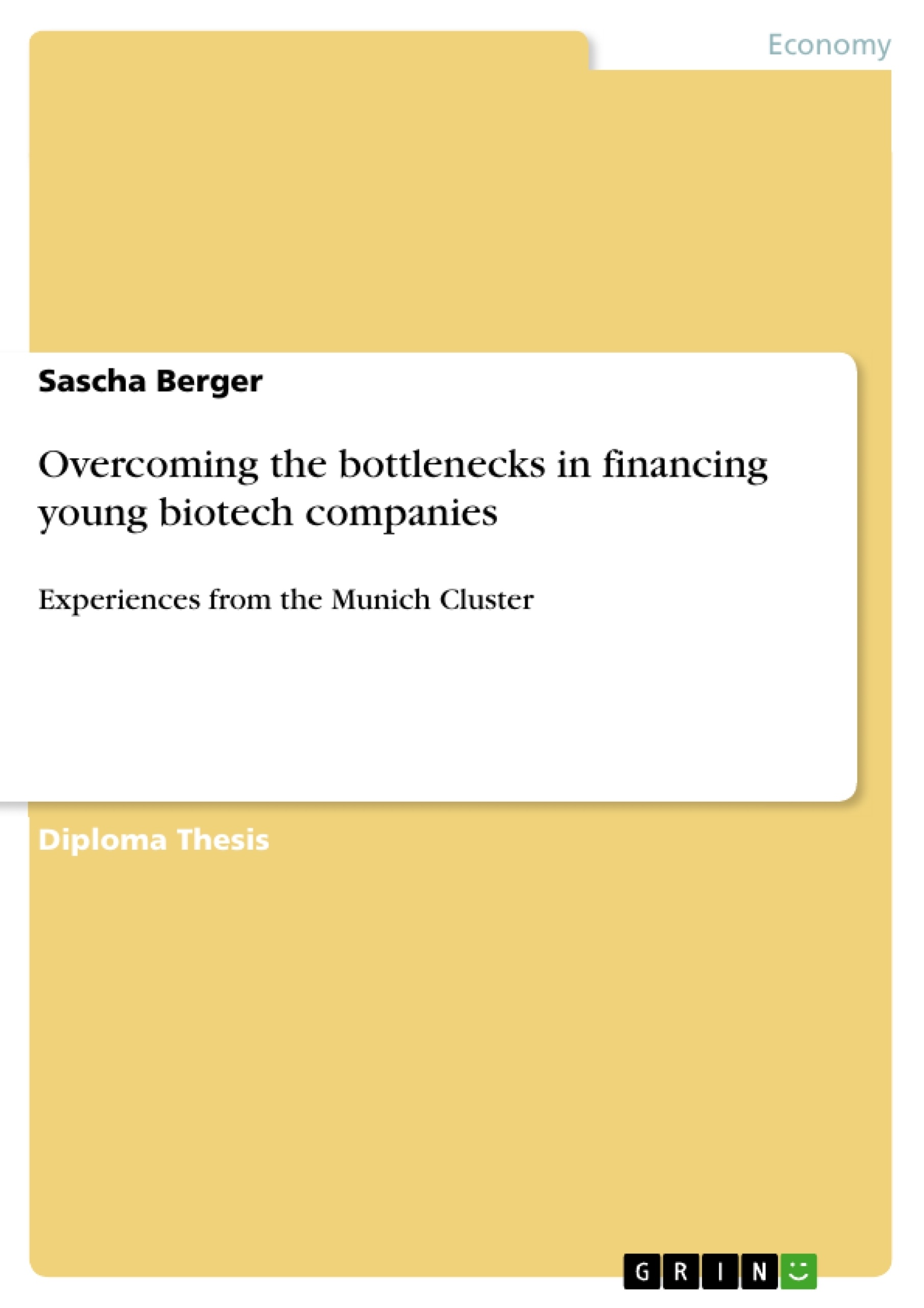In this book the question of how to overcome specific bottlenecks in financing young biotech companies was posed. The answer is manifold and includes the the usage of the multitude of financial options.
Hence, first, the unique characteristics of the industry were described and specific financial bottlenecks were revealed. The eminence of a major bottleneck, typically in the seed-phase of a biotech venture, was taken as reason for further elaborations.
I based these elaborations primarily upon an analysis of interviews. Several qualitative and predominantly personal interviews were conducted in the Munich biotech cluster, covering three decisive groups of respondents: biotech executives and founders, venture capital investors and external industry experts. The obtained extensive experiences were finally collected, clustered and compared.
My key finding was that this bottleneck is mainly rooted in the fact that, when a young biotech firm leaves the academia, a big money provider (a Venture Capitalist or corporate partner) is often not yet willing to invest. A technological proof-of-concept is demanded by the latter, which is, however, not yet sufficiently provided by the former. Cluster structures might generally be helpful, but do not change this fundamental logic either.
Based on this analysis, and taking into account the many other revealed points to improve, I came up with an exhaustive roadmap how to tackle the bottlenecks, covering all major endogenous and exogenous factors. This list of suggestions was supplemented with some basic thoughts on biotech finance strategies as also lastly a description of a comprehensive biotech finance cycle.
Inhaltsverzeichnis (Table of Contents)
- Introduction
- Definitions, Characteristics and Classifications
- Biotech
- Business Segments
- Business Categories
- Business Models
- Business Framework
- Young Companies
- Company Formation
- Growth and Challenges
- Specific Characteristics of Young Biotech Companies
- Financing
- Models of Entrepreneurial Finance
- Business Angels / Family Offices
- Venture Capital
- Subsidies
- Other Financing Instruments and Sources
- Munich Cluster
- BioRegio Contest
- Current State of the BioM Region
- Biotech
- The Challenge of Financing Young Biotech Companies
- Risks and Resultant Financial Implications
- Biotech Financing Cycles
- The Eminence of a Current Bottleneck
- Experiences from the Munich Cluster – Interview Analysis
- Scope, Sample and Sequence of Interviews
- Financial Sector Activity
- Specifications of the Bottlenecks
- Drivers of the Bottlenecks
- Starting-Points to Improve
- Financial Cluster Activity
- Financial Company Activity
- Financing Strategy
- Financing Status Quo
- Financing Lessons Learned
- Financial Investor Activity
- Investment Peripherals
- Investment Criteria
- Interview Results and Evaluation
- Tackling the Bottlenecks
- Elements of a Successful Financial Strategy
- Endogenous Strategies - Avenues for Biotech Companies
- Big Money Model I: Biotech Venture Capital
- Big Money Model II: Co-operations and Alliances
- Low Budget Model
- Exogenous Strategies - Avenues for the Framework
- Cluster and Regional Strategies
- National Strategies
- General Societal Strategies
- A Comprehensive Biotech Financing Cycle
- Summary and Outlook
Zielsetzung und Themenschwerpunkte (Objectives and Key Themes)
This thesis aims to address the research question of how to overcome specific bottlenecks in financing young biotech companies. The main objective is to identify the root causes of these bottlenecks and develop strategies to effectively address them.
- The unique challenges of financing young biotech companies
- Specific bottlenecks in financing young biotech companies
- The role of cluster structures in addressing financial challenges
- Strategies for overcoming bottlenecks at the company, regional, national, and societal levels
- The impact of personalized medicine on future financing landscapes
Zusammenfassung der Kapitel (Chapter Summaries)
Chapter 2 provides definitions and descriptions of key concepts such as biotechnology, young companies, and financing. This chapter establishes the theoretical framework for the research question and outlines the specific characteristics and challenges associated with each pillar.
Chapter 3 combines these individual pillars and elaborates on the challenge of financing young biotech companies. The chapter examines the inherent risks of the industry, its financial implications, historical financing cycles, and the prominence of a current bottleneck.
Chapter 4 presents the results of qualitative interviews conducted in the Munich biotech cluster. This chapter investigates the perspectives of biotech executives, venture capitalists, and external industry experts, exploring their experiences with financial bottlenecks and suggesting possible solutions.
Schlüsselwörter (Keywords)
The primary keywords and focus topics of this work include financing, young biotech companies, financial bottlenecks, venture capital, cluster structures, and personalized medicine. The study explores the challenges and opportunities surrounding the financing of innovative, early-stage biotechnology firms, highlighting the need for strategic approaches to address the financial gap.
- Citar trabajo
- Sascha Berger (Autor), 2007, Overcoming the bottlenecks in financing young biotech companies, Múnich, GRIN Verlag, https://www.grin.com/document/91514



